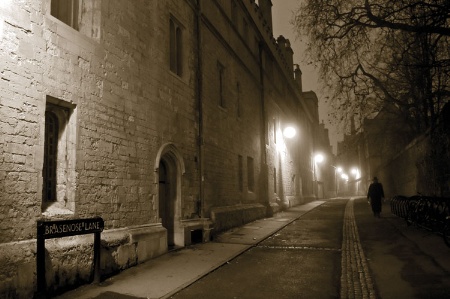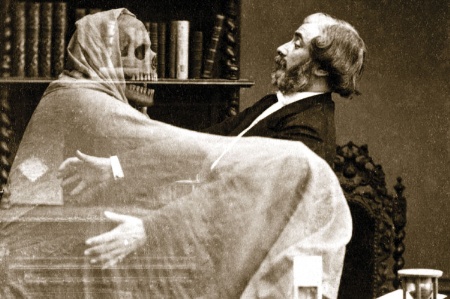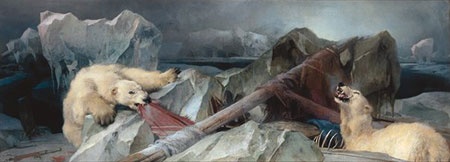Source: Alamy
“Thou art a scholar; speak to it, Horatio.”
(Hamlet, Act I, Scene I)
The Society for Psychical Research was founded at the University of Cambridge in 1882 and poltergeist activity has been a central area of its investigation
“This is the only ghost story that I know. It is a true story, and I have never seen it in print, and never heard it explained away.” So begins the tale told by a graduate of the University of Oxford, writing on 22 December 1894 in the Hampshire Telegraph.
The early part of that century, we are told, was a time when Brasenose College undergraduates “were conspicuous among their fellows for profane iniquity”. The “most audaciously iniquitous” formed a society, reviving the 18th-century Hell-Fire Club, and “its avowed purpose was the promotion of all manner of wickedness”. At its gatherings, there was no chairman, and at the head of the table stood a vacant chair, the theory being “that it was occupied by our ghostly enemy, the invisible Prince of Darkness”. One night, the principal of Brasenose had been dining at Exeter College and was returning about midnight along Brasenose Lane. “The ground-floor windows, looking out upon the lane, are barred, so that undergraduates may not issue through them upon prohibited nocturnal rambles.” When the college clock struck midnight, “a sudden flash of lurid light illuminated one of the ground-floor windows…An awful vision met his eyes. For first he saw a weird and fearful figure – a figure with horns and hoofs and a girdle of fire…whom he recognised as Apollyon, the enemy of man. And then he saw that Apollyon had hold of an undergraduate…and was dragging him violently through the window bars.” When the vision passed, the principal hurried on to the college gate and rang the bell.
It soon transpired that the Hell-Fire Club had been meeting that night. One member had stood up “to make a special parade of blasphemy”, and as he did so, had been struck down dead. We further learn that the cause of death was “something too horrible to write down here” and that, before the man’s funeral, undergraduates were invited to view the coffin in the college hall, “to find a warning for our own lives in the horrible fate that had overtaken our contemporary”.
Sadly, this is one of those university ghost stories that is probably just too good to be true. For one thing, it is exactly the kind of thing that a 19th-century clergyman might have wanted people to believe – and a clergyman was its source, having been resident in Brasenose at the time. (The Brasenose Hell-Fire Club, which did exist, was in full blaze around 1828 to 1834.) It is also hard not to feel that, as retold in 1894, the tale has something of the flavour of the stories the author M. R. James would be telling at Cambridge a few years later. They share, for example, the figure of Apollyon, from the Book of Revelation.
Let’s try another tale – this time, a little less far-fetched. At St Mary Hall, Oxford, in spring 1892, after a student, a Mr Colthurst, had been disturbed by noises in the night, another undergraduate, Mr Ackerley, waited on the staircase and was presently rewarded by “a peculiar noise, as if a walking stick standing against a wall gradually slid down and came with a clatter upon the floor”. The sound came nearer, but they could see nothing. The next night, the pair returned with a friend, Mr Vincent, armed with swords, and witnessed a small flint stone clatter to the ground, seemingly from nowhere. A little later, advancing footsteps on the stairs caused the ghost-hunters to flee ignominiously to their rooms. Were the footsteps really those of William King, a former principal of the hall? Although buried at Ealing Church, Middlesex, King had had his heart “walled up in the Hall chapel”, and it was “supposed that at intervals in his spiritual existence he feels the need of a heart, and journeys from Ealing Churchyard to Oxford to see the lost organ”, to quote from a copy of Trewman’s Exeter Flying Post published in 1892.
Again, sadly, too good to be true…The culprit turned out to be Vincent himself, who had been prompted to a fairly elaborate hoax by Ackerley’s interest in ghosts and theosophy. With some newspapers reporting the haunting as authentic, Jackson’s Oxford Journal was soon gloating about its rivals’ credulity, while by mid-March we hear of how Ackerley “has written to the papers to forgive his persecutors”.
However little truth these tales contain, they do serve to remind us that people often expect to feel, hear or see something ghostly in the kind of old buildings many universities occupy. This leads to a related possibility: namely, that certain people sense or see ghosts because there is something unusual about their brain, or because something unusual (such as infrasound or an electromagnetic field) is affecting their brain at that moment. Research on this topic (pioneered by neuropsychologist Michael Persinger at Canada’s Laurentian University) could imply that the associated hauntings are pure hallucinations. It could, however, in some cases indicate that an unusual brain state allows perception of something real, which others cannot sense or see. Scientific evidence suggests that there is often something very distinctive about the brains and bodies of people who have acted as poltergeist agents.

And this brings us to a second point about universities and ghosts: for well over 100 years now, certain academics have been taking the paranormal seriously and attempting to study it in a scientific way. Ackerley’s interest in ghosts was probably related in some degree to this new climate, with the Society for Psychical Research having been founded at the University of Cambridge in 1882. One of the central areas investigated by the society since then has been poltergeist phenomena. In such cases, objects are moved around inexplicably – sometimes violently, and sometimes very carefully. Unsourced noises are heard, varying from scratching through to rapping or thunderous hammering. Objects, substances or liquids appear from nowhere or disappear into nowhere. In a very large number of instances, these and other bizarre events closely follow one person – usually a child or adolescent, and often someone suffering some degree of emotional trauma. In some cases there is evidence to suggest the presence of a ghost; in others little or none. But what is clear is that poltergeists usually involve particular people, not particular places.
Study of the 19th century in particular shows us that there were a lot of ghost hoaxes, that many people needed little prompting or evidence to believe in a ghost and, indeed, that a startling number of people died of terror from relatively crude ghost pranks. But it also suggests that (as reported and witnessed by police, ministers and others) certain poltergeist cases are very, very difficult to explain away. If they were hoaxes, then they were probably among the most spectacular magic tricks ever performed.
What of the peculiar incidents that took place in the lodge of Sidney Sussex College, Cambridge, late on the night of Friday 6 August 1841? “The nurserymaids…were terrified by hearing several strange and mysterious noises; the sounds appeared to proceed from the staircase; presently they ceased, and the door of the nursery was slowly opened, and a figure of tall and unnatural proportions presented itself…The appearance had a head white and ghastly, long legs, also white, but the body was distinguished only by a dim outline. The body was a shadow. The affrighted maids rushed shrieking from the room – the lodge was aroused – the police were called in, but no trace of the apparition was visible, unless a curious odour which perfumed the apartment might be considered so,” reported The Morning Post on 12 August of that year.
As a hoax, this would hardly be impossible to stage. But it is very likely that one of the maids would have been the right age for a typical poltergeist agent. Both the noises and the odour fit poltergeist cases. The apparition, though more unusual, also makes some sense. In a number of well-documented instances, the ghost does indeed look like the shadow or dark outline of a person, with no features or colour. If this was a ghost and not a hoax, then it is possible that it had found sufficient energy (from the poltergeist agent) to materialise part of itself, but not all.
Compare this with the goings-on at Whittemore House, in St Louis in the US, in the 1960s. Built in 1912, this grand edifice was donated to Washington University in 1966, and is now its faculty club. Nothing supernatural was reported at Whittemore until 1967, when builders were remodelling it for its new purpose. When they did so, they are said to have discovered the bones of a child. Some thought these belonged to an infant girl who tragically choked to death in her cot on New Year’s Eve, 1936. During the renovation, builders “would set their tools down momentarily, then turn to find them moved, or gone”. The attic door would continually slam, even when propped open with a heavy doorstop. Later, with the remodelling completed, two office workers, one of whom was named Myrna, “became alarmed when they frequently heard footsteps moving down the carpeted hall – footsteps on a wooden floor”. Even “after an unseen force shoved Myrna down some stairs…she still believed that someone was playing a prank”. Accordingly, the next time Myrna heard the steps, she went out to confront her tormentor.
She found herself staring at a man with grey hair and a beard, wearing a red plaid shirt. “She was sure the man was flesh and blood, until she looked below his belt. There was nothing below his waist. He was just a torso floating above the carpet. Then he vanished,” reported the Boca Raton News.
The discovery of the bones might have predisposed people to imagine ghosts. But Myrna continued to believe in a hoaxer for as long as she could. Not only that, but she was sure that the man was real, until she noted his missing legs. Intriguingly, her sighting fits two oft-described features of ghost encounters. One is that the apparition is lacking something, whether colour, definition or part of their body. The other is that the ghost-sighter, far from being overly nervous or superstitious, is initially not looking for a spectre. In many cases, including one recounted to me by a friend, they assume the most natural explanation: this is a living person. As this implies, sometimes ghosts look as real as you or I.

Hauntings in some cases could indicate that an unusual brain state allows perceptions of something real, which others cannot sense and see
An interesting variant on this experience happened to the polymath Andrew Lang, in Oxford in 1869. On Saturday 23 October, Lang received a note stating that John Conington, the Oxford classicist, was dangerously ill. Lang responded: “He can’t have been very ill on Thursday (or yesterday, I can’t be sure which), for I met him near Corpus.” As Lang explained later: “I was under the lamp in Oriel Lane, about nine at night, in winter, and I certainly had a very good view of him…I am constantly failing to recognise people. Conington, however, was not easily mistaken, and I know no one in Oxford who was at all like him.” The problem with Lang’s sighting was not that Conington was dead, but that he was on his deathbed, 100 miles from Oxford. Although he died only on Saturday 23 October, it was later confirmed that he believed himself to be dying by the Thursday.
Lang’s attitude to the supernatural continues to be disputed long after his own death in 1912, but one biographer, William Donaldson, emphatically describes him as “bullishly sceptical”. He clearly was not expecting to see a ghost and did not believe he had seen anything unusual until he heard of Conington’s plight on the Saturday. We can only regret that this scholar – unlike Horatio – did not attempt to speak to the figure he saw in Oriel Lane.
Many of these features come together in the remarkable case of the Peterhouse ghost, which hit the headlines in December 1997. In April, two butlers at this most ancient of Cambridge colleges had gone into the 600-year-old Combination Room to collect plates. Matthew Speller, 22, told journalists: “We were chatting away when we both saw something move slowly across the room, about 15ft from the middle to the window. I just looked at Paul [Davies] and said ‘Did you see that?’” Both men described the ghost as human-sized, but said it was impossible to distinguish features or determine its sex as it travelled about one foot off the ground. They added that it stood out brightly in the dimly lit room, and that they felt a chill around them. After a further sighting the pair “felt sufficiently alarmed to interrupt a dinner to inform the Dean”. The Dean, the Reverend Graham Ward, told reporters: “I saw the absolute terror on the faces of those two, so I don’t doubt that something happened. In a college full of unreliable people, they are completely reliable.”
Many other fellows were sceptical or jocular about the claims. But matters changed when Peterhouse’s senior bursar, Andrew Murison, had a still more striking experience in November of that year. According to one report, “Murison, formerly an agnostic about ghosts, entered the dimly lit Combination Room late one evening and became aware of ‘a presence’ in one corner. ‘At first I thought it was Max Perutz, one of our Nobel Prize winners, because it was smallish, slightly built and balding,’ he said. ‘It was wearing a wide collar, like a pilgrim, and seemed to be holding a large hat. I moved closer to get a better look. I wasn’t frightened in the slightest; I was more concerned about frightening it away. It was very benign. After a few seconds, it quietly disappeared. The room was very cold, although a fire was still burning in the grate.’”
For many at Cambridge in 1997, the question was not “was there a ghost?” but “who was the ghost?” A popular choice was Frances Dawes, a bursar of Peterhouse who had hanged himself in the college in 1789, after blaming himself for the controversial and probably corrupt election of a new master. However, as William Rees-Mogg pointed out in The Times (in an article supporting the existence of ghosts), Murison’s description “suggests the costume of the 1650s; if he were the bursar who hanged himself in 1789, he ought to be wearing a cravat and a tie-wig”.
Whoever the culprit was, he was known to announce himself in typical poltergeist fashion. Murison’s first sense of something odd that night was a knocking under the window, while Speller and Davies had also heard a “rhythmical knocking which appeared to move around the panelling”. A fourth witness, the senior butler, had “noticed a solid wooden door shaking violently”. He could not open it for some time, and when the shaking stopped there was no one on the other side.
Why did this ghost appear in two such different forms? One possible answer is that, initially, it had not derived sufficient energy to manifest itself fully until November. In many poltergeist cases, the well-worn horror film staple of the sudden chill is reliably reported. It is not unreasonable to suppose that this chill is created by something sucking ambient heat from a room, precisely to gain the energy needed for manifestation.
Anyone who ever thinks they have seen a ghost and fears ridicule might be comforted by the telling words of Murison. “It was quite an extraordinary experience. I didn’t mention it to the other fellows for a while. I’m supposed to be a financial administrator, not some nutcase who goes around seeing ghosts.”

The phantom menace: curses and paranormal sightings
When the wreckage of a fabled 19th-century Arctic ship was found last month, it revived interest in a “cursed” painting on display at Royal Holloway, University of London.
Man Proposes, God Disposes (1864) was inspired by the disappearance of Sir John Franklin and two explorer ships, which set off in 1845 to find the Northwest Passage in the Canadian Arctic. The work of Edwin Henry Landseer, famed for his animal portraits, it depicts two polar bears devouring a ship’s remains – and, it appears, those of the passengers.
According to legend, students who sit directly in front of the painting during an exam “will fail – unless it’s covered up”, explains Laura MacCulloch, curator at Royal Holloway’s Picture Gallery.
It is even said that one student was so disturbed by the painting that they went mad and committed suicide. “I’ve heard it was a girl, I’ve heard it was a boy, I’ve heard about three [different] ways that they killed themselves,” MacCulloch told reporters last month, adding that no record has been found of any such death. Nonetheless, the painting is still hidden behind a Union Jack flag during exams.
Tales of paranormal activity at universities abound. The University of Wales, Newport (now part of the University of South Wales), for example, is said to be haunted by the 6ft tall ghost of Bertha Ramsey, a matron found dead after falling down the stairs during the Christmas holidays in 1962. “Since her death, there have been numerous sightings of her ghost roaming the corridors, near her room on the ground floor,” according to Rosemary Rawcliffe, who embarked on a book about the ghost during her time as a student at Newport.
At the University of Exeter, a phantom dressed in painter’s overalls has been seen walking down the corridors. And at Durham University, the ghost of Frederick Copeman, who studied at the institution in the early 19th century, is thought to roam. He lived in the highest room in Durham Castle, the story goes, and threw himself from the cathedral tower, believing that he had failed his exams. It later transpired that he had been awarded a first-class degree.
Times Higher Education reporters
Register to continue
Why register?
- Registration is free and only takes a moment
- Once registered, you can read 3 articles a month
- Sign up for our newsletter
Subscribe
Or subscribe for unlimited access to:
- Unlimited access to news, views, insights & reviews
- Digital editions
- Digital access to THE’s university and college rankings analysis
Already registered or a current subscriber? Login

